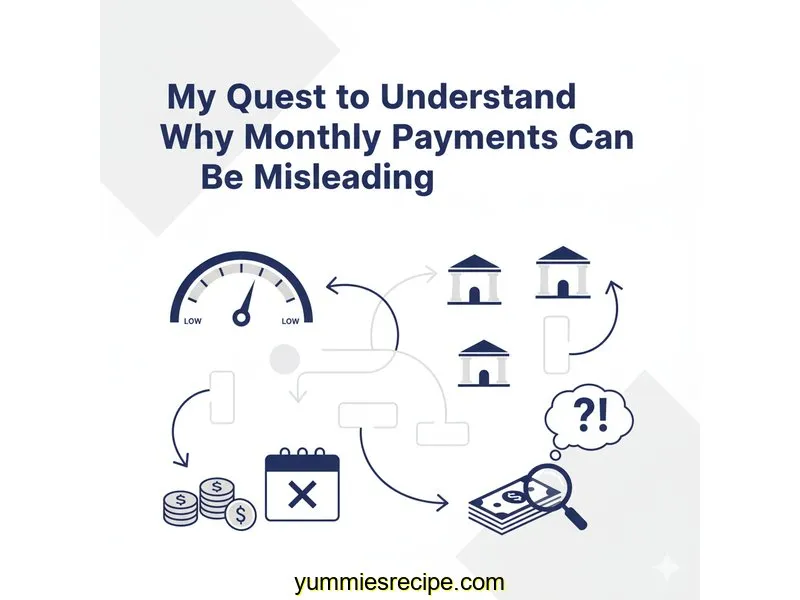
Auto Loan Calculator
Calculate payments over the life of your Loan
Home Blog Privacy Terms About Contact
Calculate payments over the life of your Loan
Home Blog Privacy Terms About ContactPublished on October 13, 2025

My journey into the world of loan calculations started with a simple, nagging question. I was looking at two hypothetical scenarios for a personal project, and a friend pointed out something that my brain just couldn't process. One option had a lower monthly payment, which to me, sounded like the obvious winner. But my friend insisted it was the "more expensive" choice. How could that be? How could paying less each month possibly result in paying more overall?
It felt like a riddle. My entire life, I’d associated "lower payment" with "better deal." It was an automatic, gut-level reaction. Seeing a payment of $294 felt so much more manageable than seeing one for $358. Yet, the math I was being told existed behind the scenes painted a completely different picture. This wasn't about making a financial decision; for me, it became a personal quest to understand the mechanics of the calculation itself. What was I missing?
I decided to dive into online loan calculators, not to find a loan, but to find an answer. I wanted to see the numbers move and change, to poke and prod the formulas until they revealed their secrets. I wasn't looking for advice; I was looking for understanding. This article is the story of that exploration—a deep dive into how loan terms, payments, and total costs interact. It's about learning to read the language of loans, not about choosing one. This is about understanding how calculations work, not financial advice.
My goal was simple: to get to a point where I could confidently explain to someone else why a lower monthly payment could actually be the more expensive path. I needed to see the math for myself and connect the dots between the monthly bill and the long-term cost. It was time to pull back the curtain on the numbers that shape these financial tools.

My first stop was a standard online loan calculator. It had fields for "Loan Amount," "Interest Rate," and "Loan Term." I felt confident. I plugged in the numbers for my hypothetical project: a loan amount of $14,850 at an interest rate of 7.3%. This is where my confusion began in earnest. I first entered a loan term of 48 months (4 years).
The calculator instantly spit out a monthly payment of around $357.69. Okay, I thought, that's my baseline. Then, I changed only one thing: the loan term. I increased it to 60 months (5 years). The new monthly payment appeared: $294.04. My brain lit up. That’s more than $60 less each month! In my mind, the case was closed. The 60-month option was clearly superior because it was easier on the monthly budget.
This is where I made my critical mistake. My focus was entirely on that one number: the monthly payment. I wrote the two payments down and stared at them, completely convinced I had all the information I needed. I spent a good ten minutes just thinking about the cash flow difference, ignoring everything else the calculator was showing me. It was like reading a book but only looking at the first word of every sentence—I was missing the entire story.
I even started to doubt my friend. Maybe they had misunderstood something. But the nagging feeling wouldn't go away. I knew there had to be more to it. I went back to the calculator page and looked closer. Below the big, bold monthly payment number were other, smaller fields: "Total Principal Paid," "Total Interest Paid," and "Total of All Payments." I had completely glossed over them, but this, I soon realized, was where the real answer was hiding.
The breakthrough didn't come from a complex formula or an obscure financial article. It came from forcing myself to look at the parts of the calculator I had initially ignored. I decided to run my two scenarios again, but this time, I would write down *every single output field* the calculator provided. This simple change in process made all the difference.
First, I ran the 48-month scenario again for the $14,850 loan at 7.3%. The monthly payment was $357.69. But this time, I looked below it. The calculator showed the "Total Interest Paid" would be $2,319.12. Then, I ran the 60-month scenario. The monthly payment was the lower $294.04, but the "Total Interest Paid" was $2,792.40. There it was, in black and white. The option with the lower monthly payment would cost me an extra $473.28 in interest.
It was a genuine "aha!" moment. Suddenly, the riddle was solved. The lower payment wasn't a magic trick; it was a trade-off. To get that lower payment, I was agreeing to pay for a longer period of time. And every extra month I was paying, I was also paying more interest. It seems so obvious in retrospect, but seeing the actual dollar amounts in the "Total Interest Paid" field was the visual proof I needed to connect the concepts.
The next piece of the puzzle fell into place when I looked at the "Total of All Payments" field. For the 48-month loan, the total was $17,169.12. For the 60-month loan, it was $17,642.40. Seeing the full, undiscounted sum of every single payment I would make laid the truth bare. The five-year option, despite its appealing monthly payment, was simply a more expensive product overall.
The math is actually quite simple once you see it. The 60-month loan has 12 extra payments compared to the 48-month loan. While each payment is smaller, those 12 extra payments add up. More importantly, for that entire extra year, interest is still being calculated on the remaining loan balance. A longer loan term means the principal balance stays higher for a longer period, giving the interest more time and a larger base to accumulate on.
Most good calculators offer an amortization schedule, and this was my final learning tool. I clicked to view the schedule for both loans. On the 60-month schedule, I could see that in the first year, a huge chunk of each $294 payment went to interest. On the 48-month schedule, a larger portion of each $358 payment went toward paying down the principal from the very beginning. This visual representation proved that the shorter-term loan attacked the principal balance much more aggressively, which in turn reduced the total amount of interest that could be charged over the life of the loan.
To make sure I truly grasped the concept, I ran a completely different scenario. I imagined a smaller loan of $9,200 at a rate of 6.8%. I compared a 36-month term to a 48-month term. Sure enough, the same pattern emerged. The 48-month term had a lower payment (around $218 vs. $283), but the total interest was higher (approx. $1,264 vs. $988). I could now predict the outcome before the calculator even finished. The relationship between term and total cost was finally clear.
This whole experience reshaped how I look at financial calculations. It wasn't about finding a "good" or "bad" loan, but about understanding the mechanics of the numbers themselves. My goal was to achieve calculation literacy, and through this process, I feel like I've gained a new perspective. Here are some of the key lessons I learned about the math itself.
As I was going through this learning process, a few key questions kept popping into my head. Here are the questions and the answers I found through my exploration of the calculators.
This happens because the loan is stretched over a longer period. A loan of 60 months has 12 more payments than a 48-month loan. During those extra 12 months, interest continues to be calculated on the remaining balance. So, while each individual payment is smaller, the cumulative amount of interest paid over those extra months adds up, increasing the total cost.
From my learning journey, the two most revealing fields are "Total Interest Paid" and "Total of All Payments." The "Total Interest Paid" shows you the direct cost of borrowing the money. The "Total of All Payments" shows you the grand total you will have paid by the end of the loan term. Comparing these two numbers between different scenarios offers a much clearer picture than just looking at the monthly payment.
Both have a significant impact, and they work together. A high interest rate will increase costs regardless of the term. However, as I discovered, a long term can make even a modest interest rate result in a very high amount of total interest paid. The term acts as a time multiplier on the rate.
The best tool for this is an amortization schedule or table, which is a feature on most good online loan calculators. It will show you a list of all your future payments, broken down into how much goes toward principal and how much goes toward interest each month. Comparing the schedule for a short-term loan versus a long-term loan makes the difference immediately obvious.
My biggest takeaway from this entire process wasn't about money, it was about understanding. I learned that being financially literate isn't about memorizing rules, but about having the curiosity to ask "why" and the patience to use the tools available to find the answer. The online calculator went from being a simple input-output machine to a powerful educational sandbox where I could test theories and see the results instantly.
The relationship between the monthly payment and the total cost of a loan is a perfect example of a financial trade-off. There isn't a universally "right" answer, only different choices that have different mathematical consequences. My goal was to understand those consequences, and I now feel equipped to see beyond the surface-level numbers.
I hope sharing my personal journey of discovery encourages you to get curious about the math behind finance, too. Playing with these calculators and focusing on how the numbers interact is a fantastic way to build confidence and truly understand what the figures mean. It’s about empowering yourself with knowledge.
This article is about understanding calculations and using tools. For financial decisions, always consult a qualified financial professional.
Disclaimer: This article documents my personal journey learning about loan calculations and how to use financial calculators. This is educational content about understanding math and using tools—not financial advice. Actual loan terms, rates, and costs vary based on individual circumstances, creditworthiness, and lender policies. Calculator results are estimates for educational purposes. Always verify calculations with your lender and consult a qualified financial advisor before making any financial decisions.
About the Author: Written by Alex, someone who spent considerable time learning to understand personal finance calculations and use online financial tools effectively. I'm not a financial advisor, accountant, or loan officer—just someone passionate about financial literacy and helping others understand how the math works. This content is for educational purposes only.